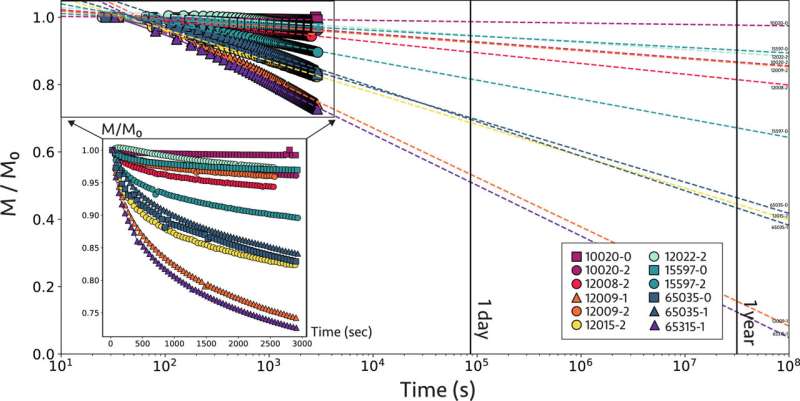This article has been reviewed according to Science X's editorial process and policies. Editors have highlighted the following attributes while ensuring the content's credibility:
fact-checked
peer-reviewed publication
trusted source
proofread
Removal of magnetic spacecraft contamination within extraterrestrial samples easily carried out, researchers say

For decades, scientists have pondered the mystery of the moon's ancient magnetism. Based on analyses of lunar samples, its now-deceased magnetic field may have been active for more than 1.5 billion years—give or take a billion years. Scientists believe it was generated like the Earth's via a dynamo process, whereby the spinning and churning of conductive liquid metal within a rocky planet's core generates a magnetic field.
However, researchers have grappled with how such a small planetary body could have sustained a long-lived magnetic field. Some have even questioned the legitimacy of return samples that point to the existence of an ancient dynamo, suggesting magnetism may have been acquired via exposure to strong magnetic fields onboard spacecraft during the return mission or from plasmas produced by massive impacts on the moon.
Stanford University scientists have now demonstrated that the magnetism in lunar samples is not adversely altered by the spacecraft journey back to Earth or certain laboratory procedures, disproving one of the two major oppositions to the ancient dynamo theory. The findings, published in Geophysical Research Letters, bode well for research stemming from other sample-return missions from space, since any magnetic contamination acquired during flight or on Earth can likely be easily removed.
"You want to know that the spacecraft returning your sample is not magnetically frying your rock, essentially," said lead study author Sonia Tikoo, an assistant professor of geophysics at the Stanford Doerr School of Sustainability.
"We simulated a long-term exposure of a sample to a stronger magnetic field than what the Earth has—something that might be realistic for a spacecraft—and found that for nearly all samples, including several we had previously studied in the context of lunar dynamo records, we could remove that contamination quite easily."
Reproducing contamination
The study authors conducted two sets of lab experiments on eight samples from four different Apollo missions. They used a magnet to expose the samples to a field strength of about 5 millitesla—about 100 times stronger than the Earth's magnetic field—for two days to approximately replicate the length of a return journey from the moon.
Then, they took the samples into a magnetically shielded lab room to measure how quickly the contamination decayed and test how easily it could be removed using standard techniques. The research shows that basalts (rocks formed by the cooling of lava flows) are generally less susceptible to acquiring magnetic contamination than glass-bearing lunar rocks, but in nearly all cases the resulting contamination could be easily removed using standard methods.
"As a global community, we're starting to send more sample-return missions to other bodies, so it's good to know that as long as we're careful to ensure spacecraft fields are not too high—and it doesn't have to be zero, necessarily—we can still do paleomagnetism studies along with other research," said Tikoo, who also holds a courtesy appointment in Earth and planetary sciences. "You don't always have to send up a heavy magnetic shield that's going to take up a lot of room and a lot of mass at the expense of other science."
Paleomagnetism is a branch of geophysics that uses remanent magnetization in rocks from the time of their formation to reconstruct the direction and/or strength of the geomagnetic field. The magnetic history of the moon is important for understanding the evolution of interior thermal history over time, in addition to how a global dynamo field may have controlled the delivery and retention of volatile substances, such as water, at the lunar surface. "An ancient lunar field may even have aided atmospheric retention on the early Earth," the study authors write.
"Paleomagnetism is a very powerful tool for understanding core processes since we cannot go to the core of the planets, and also to learn about the past behavior of the core," said study co-author Ji-In Jung, a Ph.D. student in geophysics.
Dynamo theory
Magnetic fields may protect planets' surfaces from harmful solar radiation and space weather, enabling the long-term preservation of atmospheres. While various other mechanisms for generating a magnetic field have been proposed, the dynamo theory is the widely accepted explanation of this phenomenon on Earth.
Scientists think Earth's magnetic field may have been essential for the development of conditions that support life, so learning about their presence around other planets and moons is part of the search for evidence of extraterrestrial life.
"In order to know about the internal structures of planetary bodies and their interaction with the atmosphere or other systems, we need to know about planetary dynamo processes," Jung said.
Magnetic fields can also reveal the overall cooling history of a planetary body, which can, in turn, affect its volcanism and its tectonic regime. For asteroids, researchers want to understand how magnetic fields may have helped material come together in the early solar nebula and eventually build up into larger planets.
The moon's magnetic history is of particular interest because geophysicists do not understand how a small planetary body like the moon could have generated a long-lived magnetic field, given that it has a small core that would likely have cooled quickly. As a next step, Tikoo aims to continue ongoing work to discriminate between the dynamo and impact hypotheses.
"This study proves that we can do extraterrestrial paleomagnetism with mission-returned samples," Tikoo said. "I don't think anybody doubts the ability to do Earth paleomagnetism and I'm happy that we can do it for space, too."
More information: S. M. Tikoo et al, Establishing a Lunar Origin for Paleomagnetic Records in Apollo Samples, Geophysical Research Letters (2023). doi.org/10.1029/2023GL105152 agupubs.onlinelibrary.wiley.co … 10.1029/2023GL105152
Journal information: Geophysical Research Letters
Provided by Stanford University




















